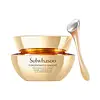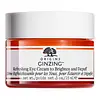What's inside
What's inside
 Key Ingredients
Key Ingredients

 Benefits
Benefits

 Concerns
Concerns

 Ingredients Side-by-side
Ingredients Side-by-side

Water
Skin ConditioningButylene Glycol
HumectantSqualane
EmollientGlycerin
HumectantPropanediol
SolventBehenyl Alcohol
EmollientDiisostearyl Malate
EmollientDimethicone
EmollientPolyglyceryl-3 Methylglucose Distearate
EmulsifyingHydrogenated Castor Oil Isostearate
Skin ConditioningPhytosteryl Isostearyl Dimer Dilinoleate
EmollientButyrospermum Parkii Butter
Skin ConditioningPhytosteryl/Behenyl/Octyldodecyl Lauroyl Glutamate
Skin ConditioningStearic Acid
CleansingGlyceryl Stearate
EmollientPEG-100 Stearate
1,2-Hexanediol
Skin ConditioningMethoxy PEG-114/Polyepsilon Caprolactone
BufferingPolyacrylate-13
Phenoxyethanol
PreservativePanax Ginseng Root Extract
EmollientPolyisobutene
Hydrolyzed Ginseng Saponins
Skin ConditioningCaffeine
Skin ConditioningHoney
HumectantAlcohol
AntimicrobialParfum
MaskingNelumbo Nucifera Flower Extract
Skin ConditioningPolygonatum Officinale Rhizome/Root Extract
Skin ConditioningRehmannia Glutinosa Root Extract
Skin ConditioningPaeonia Albiflora Root Extract
Skin ConditioningLilium Candidum Bulb Extract
Skin ConditioningEthylhexylglycerin
Skin ConditioningPolysorbate 20
EmulsifyingSorbitan Isostearate
EmulsifyingDisodium EDTA
Sodium Polyacrylate
AbsorbentTheobroma Cacao Extract
Skin ConditioningDextrin
AbsorbentGlycyrrhiza Uralensis Root Extract
Skin ConditioningAlpha-Isomethyl Ionone
PerfumingLimonene
PerfumingHydrogenated Lecithin
EmulsifyingLinalool
PerfumingPanax Ginseng Flower Extract
AntioxidantHydroxyisohexyl 3-Cyclohexene Carboxaldehyde
MaskingHexyl Cinnamal
PerfumingPhytosphingosine
Skin ConditioningSodium Polyaspartate
HumectantTocopherol
AntioxidantSodium Methyl Stearoyl Taurate
CleansingWater, Butylene Glycol, Squalane, Glycerin, Propanediol, Behenyl Alcohol, Diisostearyl Malate, Dimethicone, Polyglyceryl-3 Methylglucose Distearate, Hydrogenated Castor Oil Isostearate, Phytosteryl Isostearyl Dimer Dilinoleate, Butyrospermum Parkii Butter, Phytosteryl/Behenyl/Octyldodecyl Lauroyl Glutamate, Stearic Acid, Glyceryl Stearate, PEG-100 Stearate, 1,2-Hexanediol, Methoxy PEG-114/Polyepsilon Caprolactone, Polyacrylate-13, Phenoxyethanol, Panax Ginseng Root Extract, Polyisobutene, Hydrolyzed Ginseng Saponins, Caffeine, Honey, Alcohol, Parfum, Nelumbo Nucifera Flower Extract, Polygonatum Officinale Rhizome/Root Extract, Rehmannia Glutinosa Root Extract, Paeonia Albiflora Root Extract, Lilium Candidum Bulb Extract, Ethylhexylglycerin, Polysorbate 20, Sorbitan Isostearate, Disodium EDTA, Sodium Polyacrylate, Theobroma Cacao Extract, Dextrin, Glycyrrhiza Uralensis Root Extract, Alpha-Isomethyl Ionone, Limonene, Hydrogenated Lecithin, Linalool, Panax Ginseng Flower Extract, Hydroxyisohexyl 3-Cyclohexene Carboxaldehyde, Hexyl Cinnamal, Phytosphingosine, Sodium Polyaspartate, Tocopherol, Sodium Methyl Stearoyl Taurate
Water
Skin ConditioningMethyl Trimethicone
Skin ConditioningButylene Glycol
HumectantPEG-100 Stearate
Dimethicone
EmollientCetyl Ricinoleate
EmollientSilica
AbrasiveOlea Europaea Fruit Oil
MaskingGlycerin
HumectantBehenyl Alcohol
EmollientCucumis Sativus Fruit Extract
EmollientPanax Ginseng Root Extract
EmollientCastanea Sativa Seed Extract
Skin ConditioningCamellia Sinensis Leaf Extract
AntimicrobialCordyceps Sinensis Extract
AntioxidantMagnolia Officinalis Bark Extract
AntimicrobialPyrus Malus Fruit Extract
Skin ConditioningScutellaria Baicalensis Root Extract
AstringentPantethine
EmollientPanthenol
Skin ConditioningCaprylic/Capric Triglyceride
MaskingButyrospermum Parkii Butter
Skin ConditioningCaffeine
Skin ConditioningUsnea Barbata Extract
Yeast Extract
Skin ConditioningFolic Acid
Skin ConditioningHydrogenated Lecithin
EmulsifyingJojoba Wax PEG-120 Esters
Biotin
AntiseborrhoeicTribehenin
EmollientMyristyl Alcohol
EmollientPalmitoyl Tetrapeptide-7
Skin ConditioningTrehalose
HumectantSodium Hyaluronate
HumectantAscorbyl Tocopheryl Maleate
AntioxidantHesperidin Methyl Chalcone
AntioxidantSodium Sulfite
PreservativeSodium Metabisulfite
AntioxidantSteareth-20
CleansingDipeptide-2
Skin ConditioningEthylhexylglycerin
Skin ConditioningCarbomer
Emulsion StabilisingTromethamine
BufferingSorbic Acid
PreservativeChlorphenesin
AntimicrobialPhenoxyethanol
PreservativeMica
Cosmetic ColorantCI 77891
Cosmetic ColorantIron Oxides
Water, Methyl Trimethicone, Butylene Glycol, PEG-100 Stearate, Dimethicone, Cetyl Ricinoleate, Silica, Olea Europaea Fruit Oil, Glycerin, Behenyl Alcohol, Cucumis Sativus Fruit Extract, Panax Ginseng Root Extract, Castanea Sativa Seed Extract, Camellia Sinensis Leaf Extract, Cordyceps Sinensis Extract, Magnolia Officinalis Bark Extract, Pyrus Malus Fruit Extract, Scutellaria Baicalensis Root Extract, Pantethine, Panthenol, Caprylic/Capric Triglyceride, Butyrospermum Parkii Butter, Caffeine, Usnea Barbata Extract, Yeast Extract, Folic Acid, Hydrogenated Lecithin, Jojoba Wax PEG-120 Esters, Biotin, Tribehenin, Myristyl Alcohol, Palmitoyl Tetrapeptide-7, Trehalose, Sodium Hyaluronate, Ascorbyl Tocopheryl Maleate, Hesperidin Methyl Chalcone, Sodium Sulfite, Sodium Metabisulfite, Steareth-20, Dipeptide-2, Ethylhexylglycerin, Carbomer, Tromethamine, Sorbic Acid, Chlorphenesin, Phenoxyethanol, Mica, CI 77891, Iron Oxides
 Reviews
Reviews

Ingredients Explained
These ingredients are found in both products.
Ingredients higher up in an ingredient list are typically present in a larger amount.
Behenyl Alcohol is a type of fatty alcohol (these are different from the drying, solvent alcohols).
Fatty Alcohols have hydrating properties and are most often used as an emollient or to thicken a product. They are usually derived from natural fats and oils; behenyl alcohol is derived from the fats of vegetable oils.
Emollients help keep your skin soft and hydrated by creating a film that traps moisture in.
In 2000, Behenyl Alcohol was approved by the US as medicine to reduce the duration of cold sores.
Learn more about Behenyl AlcoholButylene Glycol (or BG) is used within cosmetic products for a few different reasons:
Overall, Butylene Glycol is a safe and well-rounded ingredient that works well with other ingredients.
Though this ingredient works well with most skin types, some people with sensitive skin may experience a reaction such as allergic rashes, closed comedones, or itchiness.
Learn more about Butylene GlycolThis ingredient is also known as shea butter. It is an effective skin hydrator and emollient.
Emollients help soothe and soften your skin. It does this by creating a protective film on your skin. This barrier helps trap moisture and keeps your skin hydrated. Emollients may be effective at treating dry or itchy skin.
Shea butter is rich in antioxidants. Antioxidants help fight free-radicals, or molecules that may harm the body. It is also full of fatty acids including stearic acid and linoleic acid. These acids help replenish the skin and keep skin moisturized.
While Shea Butter has an SPF rating of about 3-4, it is not a sunscreen replacement.
Shea butter may not be fungal acne safe. We recommend speaking with a professional if you have any concerns.
Learn more about Butyrospermum Parkii ButterCaffeine is most associated with coffee, tea, and cacao. In skincare, it helps with calming inflammation and is rich in antioxidants.
While caffeine is used to treat cellulite and and dark circles, further studies are needed to prove this. It has been believed to help with these skin conditions due to its ability to dilate blood vessels and increase blood flow.
Some studies are looking into caffeine's ability to protect against UV rays.
Learn more about CaffeineDimethicone is a type of synthetic silicone created from natural materials such as quartz.
What it does:
Dimethicone comes in different viscosities:
Depending on the viscosity, dimethicone has different properties.
Ingredients lists don't always show which type is used, so we recommend reaching out to the brand if you have questions about the viscosity.
This ingredient is unlikely to cause irritation because it does not get absorbed into skin. However, people with silicone allergies should be careful about using this ingredient.
Note: Dimethicone may contribute to pilling. This is because it is not oil or water soluble, so pilling may occur when layered with products. When mixed with heavy oils in a formula, the outcome is also quite greasy.
Learn more about DimethiconeEthylhexylglycerin (we can't pronounce this either) is commonly used as a preservative and skin softener. It is derived from glyceryl.
You might see Ethylhexylglycerin often paired with other preservatives such as phenoxyethanol. Ethylhexylglycerin has been found to increase the effectiveness of these other preservatives.
Glycerin is already naturally found in your skin. It helps moisturize and protect your skin.
A study from 2016 found glycerin to be more effective as a humectant than AHAs and hyaluronic acid.
As a humectant, it helps the skin stay hydrated by pulling moisture to your skin. The low molecular weight of glycerin allows it to pull moisture into the deeper layers of your skin.
Hydrated skin improves your skin barrier; Your skin barrier helps protect against irritants and bacteria.
Glycerin has also been found to have antimicrobial and antiviral properties. Due to these properties, glycerin is often used in wound and burn treatments.
In cosmetics, glycerin is usually derived from plants such as soybean or palm. However, it can also be sourced from animals, such as tallow or animal fat.
This ingredient is organic, colorless, odorless, and non-toxic.
Glycerin is the name for this ingredient in American English. British English uses Glycerol/Glycerine.
Learn more about GlycerinHydrogenated Lecithin is created from the hydrogenation of lecithin (a group of phospholipids). Hydrogenation is a chemical reaction between hydrogen and another element.
This ingredient is an emollient and emulsifier. As an emollient, it helps soften skin by trapping moisture within. As an emulsifier, it prevents oil and water ingredients from separating.
Ginseng root is a well-loved ingredient in Asian skincare for good reason. It hydrates the skin, soothes irritation, and helps even out skin tone.
In traditional East Asian medicine, ginseng has been used for centuries both as food and as a healing remedy, and modern research continues to confirm its skin benefits.
One of the standout features of ginseng is its ability to improve blood circulation and oxygen delivery to the skin, bringing a fresh supply of nutrients to support overall skin health. It also has antioxidant and anti-inflammatory properties. This helps to protect your skin against damage from UV exposure, pollution, and daily stress.
Additionally, studies suggest that ginseng may help reduce hyperpigmentation by inhibiting tyrosinase, the enzyme involved in melanin production.
There are different types of ginseng used in skincare, and while they all share core benefits, their potency can vary.
Most products use fresh or white ginseng because it’s more affordable. However, red ginseng, produced by steaming the root, contains higher levels of ginsenosides, which are compounds with proven anti-aging effects. These ginsenosides help reduce the appearance of wrinkles and improve skin elasticity.
Note: All forms of ginseng are listed simply as “Panax ginseng” in ingredient lists. We recommend reaching out to the brand if you have questions about which type of ginseng is used in their ingredients.
For general antioxidant benefits, any ginseng extract will do, but for wrinkle care or firmer skin, red or fermented ginseng is often more effective.
In short, ginseng is a powerhouse ingredient that supports hydration, radiance, and resilience.
Learn more about Panax Ginseng Root ExtractPeg-100 Stearate is an emollient and emulsifier. As an emollient, it helps keep skin soft by trapping moisture in. On the other hand, emulsifiers help prevent oil and water from separating in a product.
PEGS are a hydrophilic polyether compound . There are 100 ethylene oxide monomers in Peg-100 Stearate. Peg-100 Stearate is polyethylene glycol ester of stearic acid.
Phenoxyethanol is a preservative that has germicide, antimicrobial, and aromatic properties. Studies show that phenoxyethanol can prevent microbial growth. By itself, it has a scent that is similar to that of a rose.
It's often used in formulations along with Caprylyl Glycol to preserve the shelf life of products.
Water. It's the most common cosmetic ingredient of all. You'll usually see it at the top of ingredient lists, meaning that it makes up the largest part of the product.
So why is it so popular? Water most often acts as a solvent - this means that it helps dissolve other ingredients into the formulation.
You'll also recognize water as that liquid we all need to stay alive. If you see this, drink a glass of water. Stay hydrated!
Learn more about Water